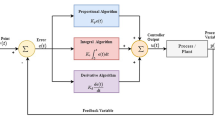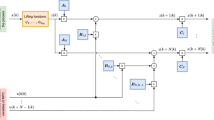Abstract
There is a class of typical nonlinear industrial process, which can be characterized by a first-order inertia plus pure delay model in an operating range, but the model parameters are different in different operating ranges. Usually, a set of Proportion Integration Differentiation (PID) controllers may be used to control the process, and the controllers have different parameters in different operating areas. However, the adjustment process of the PID controllers’ parameters is not an easy job in practice, and the control performance may also be not perfect. The Dahlin algorithm may provide very good control performance for the process, but its control performance may become very poor if the model parameters are not accurate and/or the input is constrained. Faced with this issue, this paper proposes an Operating-Range Scheduled Robust Dahlin Algorithm (ORSRDA) for the process control with input constraint, which is designed on the basis of a nominal first-order inertia plus pure delay model and the given parameters uncertainty. The process operating ranges are divided into pre-designed several zones according to the difference between output setting value and current output when a new setting appears. For each operating range, the parameters of ORSRDA are obtained by solving a min-max problem offline to guarantee the closed-loop system’s robust stability and acquire the best step-response control performance. To eliminate the steady state error, the integration control action is added into the ORSRDA when the system output is close to its setting value. The proposed method is applied to temperature control of an experimental electric furnace to demonstrate its effectiveness and implement procedure.
Similar content being viewed by others
References
C. A. Lua, S. D, Gennaro, and M. E. S. Morales, “Nonlinear adaptive controller applied to an Antilock Braking System with parameters variations,” Int. J. Control Autom. Syst., vol. 15, no. 2, pp. 1–10, 2017.
B. B. Gao, S. S. Gao, Y. M. Zhong, G. G, Hu, and C. F, Gu, “Interacting multiple model estimation-based adaptive robust unscented Kalman filter,” Int. J. Control Autom. Syst., vol. 15, no. 5, pp. 2013–2025, 2017.
Y. F, Wu and M. C, Deng, “Operator-based robust nonlinear optimal vibration control for an L-shaped arm driven by linear pulse motor,” Int. J. Control Autom. Syst., vol. 15, no. 5, pp. 2026–2033, 2017.
Y. Chen and Q. W, Yang, “Design and simulation of Fuzzy Smith intelligent temperature controller,” Control Engineering of China, vol. 14, no. 4, pp. 422–429, 2007.
R. Q. Wang, K. Li, N. X, Cui, and C. H, Zhang, “A new PID-type fuzzy neural network controller based on genetic algorithm with improved Smith predictor,” Proc. of IEEE Conference on Decision and Control and 28th Chinese Control Conference, pp. 16–18, 2009.
Y. W, Chen and T. Y. Chai, “Hybrid intelligent preprocessing system of parameters in heating furnace control,” Proc. of International Conference on Natural Computation, pp. 1433–1437, 2010.
J. J. He, Y. Q. Liu, S. Y. Yu, and W. H, Gui, “Neural adaptive PSD decoupling controller and its application in three-phase electrode adjusting system of submerged arc furnace,” Journal of Central South University, vol. 20, pp. 405–412, 2013.
L. Li and Z. Z, Mao, “A novel robust adaptive controller for EAF electrode regulator system based on approximate model method,” Journal of Central South University, vol. 19, pp. 2158–2166, 2012.
G. C. Goodwin, R. H. Middleton, M. M, Seron, and B. Campos, “Application of nonlinear model predictive control to an industrial induction heating furnace,” Annual Reviews in Control, vol. 37, pp. 271–277, 2013.
M. Suzuki, K. Katsuki, J. I. Imura, J. I. Nakagawa, T. Kurokawa, and K. Aihara, “Simultaneous optimization of slab permutation scheduling and heat controlling for a reheating furnace,” Journal of Process Control, vol. 24, pp. 225–238, 2014.
Y. Y. Yang, “Development of a dynamic control model for walking beam reheating furnace,” Control and Decision, vol. 3, no. 3, pp. 51–53, 1988.
L. Wang, H. Q. Ni, R. X. Yang, P. M. Pardalos, J. Li, and M. R, Fei, “Intelligent virtual reference feedback tuning and its application to heat treatment electric furnace control,” Engineering Applications of Articial Intelligence, vol. 46, pp. 1–9, 2015.
T. Y. Chai, “Optimal setting model of reheat furnace temperature,” Acta Automatica Sinica, vol. 26, no. 4, pp. 537–541, 2000.
Y. Y. Tan, J. H, Song, and S. X, Liu, “Model and algorithm for scheduling reheating furnace,” Control Theory & Applications, vol. 28, no. 11, pp. 1549–1557, 2011.
S. S. Ning, W. Wang, and Q. L, Liu, “An optimal scheduling algorithm for reheating furnace in steel production,” Control and Decision, vol. 21, no. 10, pp. 1138–1142, 2006.
E. B. Dahlin, “Designing and tuning digital controllers,” Instruin. Control Syst., vol. 41, pp. 77–83, 1968.
X. Zhao and R. Y, Li, “Comparison and analysis of Dahlin and Dead-beat algorithm for control system,” Industry and Information Education Technology, vol. 1, pp. 37–49, 2016.
Y. H. Tan, “Some research on Dahlin algorithm,” Control and Instruments in Chemical Industry, vol. 17, no. 4, pp. 18–20, 1990.
J. D, Liu and Q. S, Kong, “Boiler temperature control system with Dahlin algorithm,” Fudan University, Shanghai, 2009.
Z. Q, Zheng and Y H. Zhang, “Study on model mismatch time-delay control system based on Dahlin,” Applied Energy Technology, vol. 8, pp. 1–5, 2014.
L. J. Yang, Q. M, Li, and D. Y. Gu, “Dahlin algorithm application in a temperature control system,” Chinese Journal of Scientific Instrument, vol. 26, no. 8, pp. 450–454, 2005.
D. Y. Liang and J. J, Chen, “Simulation research of some aspects on Dahlin algorithm,” Journal of Central South University, vol. 1, no. 39, pp. 103–112, 1984.
C. L. Liu, P. F. Yang, and T. Ning, “Temperature control system of atmospheric petrochemical furnace based on Dahlin-Smith compensation,” Journal of Electronic Measurement and Instrument, vol. 23, no. 2, pp. 89–93, 2009.
H. Xia and T. Xia, “Implementation of the Dahlin digital controller by IIR network method,” Proc. of International Conference on Intelligent Computation Technology and Automation, pp. 621–624, 2009.
D. D. Wen, “Study on adaptive fuzzy-Dahlin control for system with time-varying,” Proc. of International Conference on Intelligent Computation Technology and Automation, pp. 792–795, 2009.
X. L. Yang, Y. R, Du, and Z. Li, “A medical infusion heating system based on Dahlin algorithm,” Proc. of International Conference on Information and Automation, pp. 1263–1267, 2008.
W. Shen, L. S, Hu, and H. H, Shao, “Flow control based on Dahlin control algorithm in ATM networks,” Proceedings of the American Control Conference, pp. 2449–2454, 2002.
S. S. Hu, Automatic Control Theory, Science Press, Beijing, pp. 348–357, 2007.
R. H. Wang, B. X, Xue, and J. B, Zhao, “Time-varying control for discrete-time switched systems with admissible edge-dependent average dwell time,” Int. J. Control Autom. Syst., vol. 17, no. 8, pp. 1921–1934, 2019.
J. H. Yi, K. H. Park, S. H. Kim, Y. K. Kwak, M. Ab-delfatah, and I. Busch-Vishniac, “Robust force control for a magnetically levitated manipulator using flux density measurement,” Control Engineering Practice, vol. 4, no. 7, pp. 957–965, 1996.
R. Fales and A. Kelkar, “Robust control design for a wheel loader using mixed sensitivity H-inflnity and feedback linearization based methods,” Proceedings of the American Control Conference, pp. 4381–4386, 2005.
Author information
Authors and Affiliations
Corresponding author
Additional information
Publisher’s Note Springer Nature remains neutral with regard to jurisdictional claims in published maps and institutional affiliations.
Recommended by Associate Editor Niket Kaisare under the direction of Editor Myo Taeg Lim. This work was supported by the National Natural Science Foundation of China (61773402, 51575167, 61540037).
Xiaoying Tian obtained her M.Eng degree in Control Science and Engineering from Henan Polytechnic University, Jiaozuo, China, in 2015. She is currently working towards a Ph.D. in Control Science and Engineering at the Central South University, Changsha, China. Her current research interests are in complex systems modeling, optimization, and control.
Hui Peng received his B.Eng. and M.Eng degrees in control science and engineering from the Central South University, Changsha, China, in 1983 and 1986, and his Ph.D. degree in Statistical Science from the Graduate University for Advanced Studies, Japan, in 2003. He has been a Professor at the Central South University, Changsha, China, since 1998. His research interests include complex systems modeling, control and optimization; advanced control theory and intelligent automation system; industrial process control system development. Corresponding author of this paper.
Xuguang Luo received his B.Eng. and M.Eng degrees in control science and engineering from the Central South University, Changsha, China, in 2014 and 2017, respectively. His current research interests are in algorithm, embedded system and technology commercialization.
Shiyuan Nie received her B.Eng. and M.Eng degrees in control science and engineering from the Central South University, Changsha, China, in 2014 and 2017. Her research interests are in complex systems modeling, optimization and control.
Feng Zhou received his B.Eng., M.Eng, and Ph.D. degrees in control science and engineering from the Central South University, Changsha, China, in 2005, 2009, and 2017, respectively. His current research interests are in complex systems modeling, optimization and control.
Xiaoyan Peng received her B.S. and M.S. degrees in mechanical engineering and a Ph.D. degree in automatic control from Hunan University, Changsha, China, in 1986, 1989, and 2013, respectively. She is currently a Professor in the College of Mechanical and Vehicle Engineering, Hunan University. Her research interests cover control of mechatronic systems and safety analysis of autonomous vehicles.
Rights and permissions
About this article
Cite this article
Tian, X., Peng, H., Luo, X. et al. Operating Range Scheduled Robust Dahlin Algorithm to Typical Industrial Process with Input Constraint. Int. J. Control Autom. Syst. 18, 897–910 (2020). https://doi.org/10.1007/s12555-017-0714-x
Received:
Revised:
Accepted:
Published:
Issue Date:
DOI: https://doi.org/10.1007/s12555-017-0714-x




